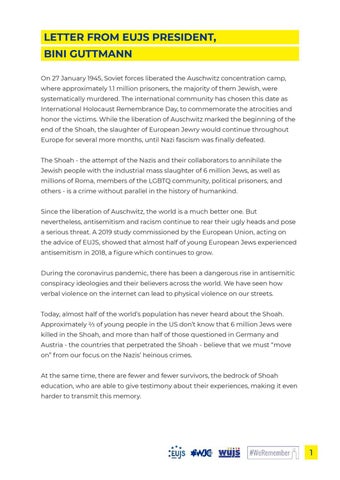LETTER FROM EUJS PRESIDENT, BINI GUTTMANN On 27 January 1945, Soviet forces liberated the Auschwitz concentration camp, where approximately 1.1 million prisoners, the majority of them Jewish, were systematically murdered. The international community has chosen this date as International Holocaust Remembrance Day, to commemorate the atrocities and honor the victims. While the liberation of Auschwitz marked the beginning of the end of the Shoah, the slaughter of European Jewry would continue throughout Europe for several more months, until Nazi fascism was finally defeated. The Shoah - the attempt of the Nazis and their collaborators to annihilate the Jewish people with the industrial mass slaughter of 6 million Jews, as well as millions of Roma, members of the LGBTQ community, political prisoners, and others - is a crime without parallel in the history of humankind. Since the liberation of Auschwitz, the world is a much better one. But nevertheless, antisemitism and racism continue to rear their ugly heads and pose a serious threat. A 2019 study commissioned by the European Union, acting on the advice of EUJS, showed that almost half of young European Jews experienced antisemitism in 2018, a figure which continues to grow. During the coronavirus pandemic, there has been a dangerous rise in antisemitic conspiracy ideologies and their believers across the world. We have seen how verbal violence on the internet can lead to physical violence on our streets. Today, almost half of the world’s population has never heard about the Shoah. Approximately ⅔ of young people in the US don’t know that 6 million Jews were killed in the Shoah, and more than half of those questioned in Germany and Austria - the countries that perpetrated the Shoah - believe that we must “move on” from our focus on the Nazis’ heinous crimes. At the same time, there are fewer and fewer survivors, the bedrock of Shoah education, who are able to give testimony about their experiences, making it even harder to transmit this memory.
1








